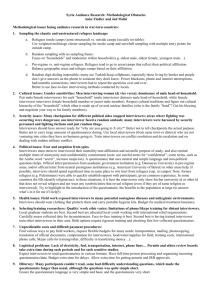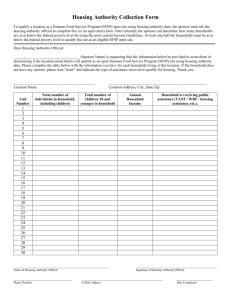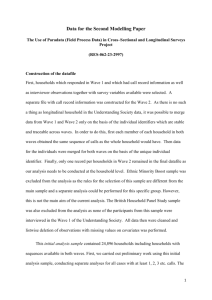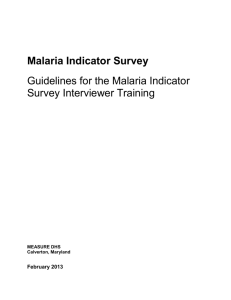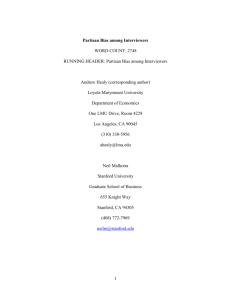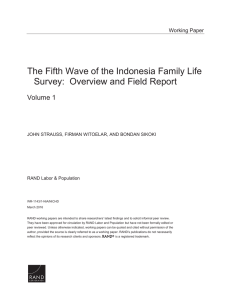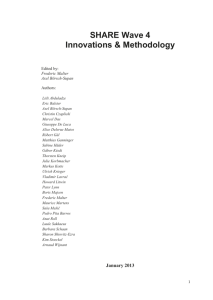DataPaper2
advertisement
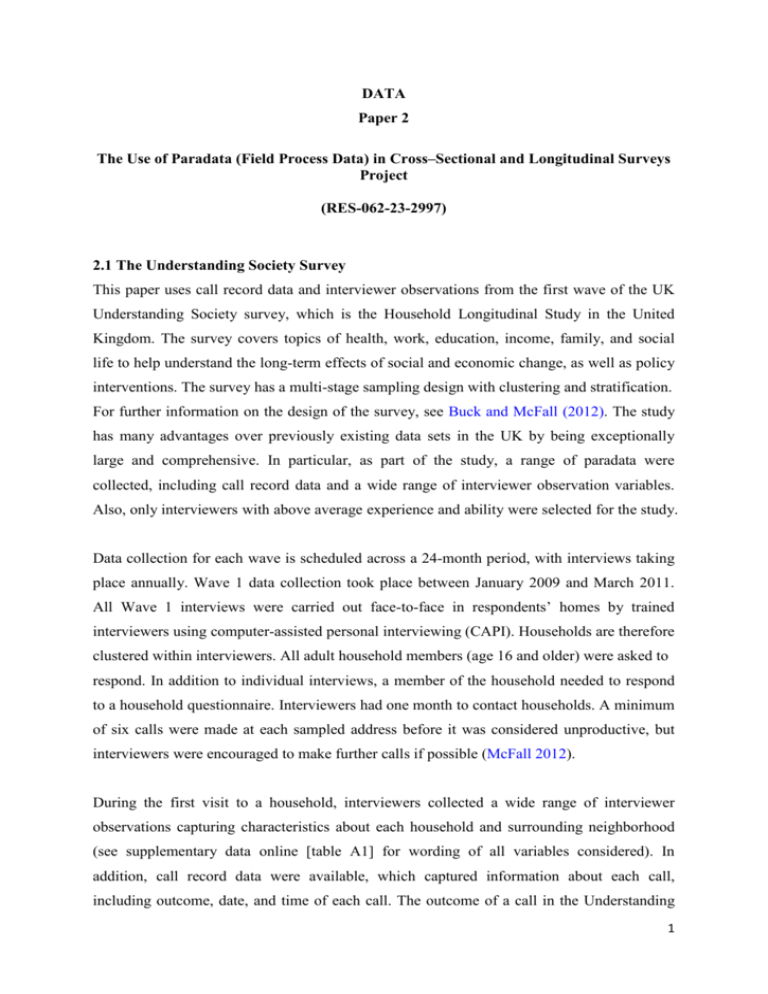
DATA Paper 2 The Use of Paradata (Field Process Data) in Cross–Sectional and Longitudinal Surveys Project (RES-062-23-2997) 2.1 The Understanding Society Survey This paper uses call record data and interviewer observations from the first wave of the UK Understanding Society survey, which is the Household Longitudinal Study in the United Kingdom. The survey covers topics of health, work, education, income, family, and social life to help understand the long-term effects of social and economic change, as well as policy interventions. The survey has a multi-stage sampling design with clustering and stratification. For further information on the design of the survey, see Buck and McFall (2012). The study has many advantages over previously existing data sets in the UK by being exceptionally large and comprehensive. In particular, as part of the study, a range of paradata were collected, including call record data and a wide range of interviewer observation variables. Also, only interviewers with above average experience and ability were selected for the study. Data collection for each wave is scheduled across a 24-month period, with interviews taking place annually. Wave 1 data collection took place between January 2009 and March 2011. All Wave 1 interviews were carried out face-to-face in respondents’ homes by trained interviewers using computer-assisted personal interviewing (CAPI). Households are therefore clustered within interviewers. All adult household members (age 16 and older) were asked to respond. In addition to individual interviews, a member of the household needed to respond to a household questionnaire. Interviewers had one month to contact households. A minimum of six calls were made at each sampled address before it was considered unproductive, but interviewers were encouraged to make further calls if possible (McFall 2012). During the first visit to a household, interviewers collected a wide range of interviewer observations capturing characteristics about each household and surrounding neighborhood (see supplementary data online [table A1] for wording of all variables considered). In addition, call record data were available, which captured information about each call, including outcome, date, and time of each call. The outcome of a call in the Understanding 1 Society survey is defined as non-contact, contact, appointment, interview, and “any other status” (which includes ineligibles and refusals as coded by the survey agency). For this study, call record data, including final response outcome, are combined with interviewer observation data, variables about the study design, and geographic information, using a unique household identifier. All variables are available for both respondents and nonrespondents. 2.2 Analysis Sample and Definition of Explanatory Variables The analysis was initially carried out on all households from Wave 1, excluding cases from an Ethnic Minority Boost sample as rules for the selection of this sample differ from the main sample. A separate analysis could be undertaken for this group. This distinction is, however, not of interest here. Ineligibles are included in our analysis since it is a true outcome and survey agencies may be interested in mechanisms for identifying ineligibles as early as possible to reduce survey costs. This initial analysis sample contained 47,913 households (including both responding and nonresponding households). First, we carried out preliminary work using this initial analysis sample, conducting separate analyses for all cases with at least 1, 2, 3, etc. calls. The aim was to evaluate after every call how well we can predict final outcome and length as more information about each case becomes available. This preliminary analysis suggested that three calls may be sufficient to reach an acceptable level of predictability. To more formally assess this, we explore a range of models to predict length and outcome. However, to be able to compare model fit and prediction across the different models—since measures of predictability are dependent on sample size— we have to restrict our final analysis sample for evaluation purposes only to all households from Wave 1 that received four or more calls (27,995 households), although in survey practice the models can be fitted to all the available cases. There are no missing cases in any of the geographic information and design variables since these are derived from administrative data. Date and time of a call are automatically captured using computer-assisted methods, leading to no missing cases in these variables. Recordings of the call outcome contained a very small amount of missing data, and such calls were excluded (311 cases). Since we are interested in the usefulness of interviewer observation variables, we condition on the availability of such variables (removing 2,015 cases, equivalent to 7.2 percent). The final analysis sample, including only cases with four or more calls, contains 25,358 households and 734 interviewers. 2 The explanatory variables used in the analysis to model call sequence length and outcome can be split into three main groups (for the full list of variables, see the supplementary data online [table A1]). The distributions of the explanatory variables are presented in the supplementary data online (table A2): (1) geographic information and design variables (4 variables: urban/rural indicator, government office region, low-density area for ethnic minorities, and month of household issue); (2) interviewer observation variables (14 variables, e.g., indicators of entry barriers, conditions of surrounding area such as litter in street, abandoned buildings, heavy traffic, type of accommodation, presence of children in a household, relative condition of the property, garden); (3) call record variables (20 variables, e.g., time of day, day of week, call outcome; also derived variables, including time between calls, number of previous non-contacts, contacts, appointments, and broken appointments). 3

